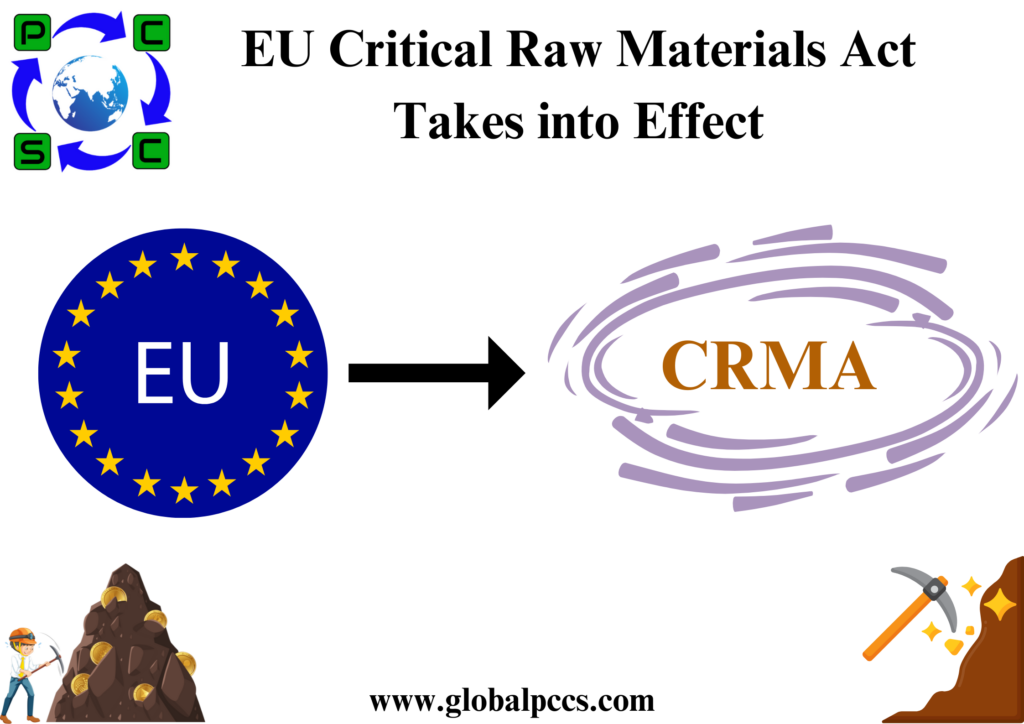 In May, 2024, the EU implemented Regulation (EU) 2024/12521, known as the Critical Raw Materials Act (CRMA), to establish a framework ensuring a secure and sustainable supply of critical raw materials. The CRMA officially took effect on May 23, 2024.
In May, 2024, the EU implemented Regulation (EU) 2024/12521, known as the Critical Raw Materials Act (CRMA), to establish a framework ensuring a secure and sustainable supply of critical raw materials. The CRMA officially took effect on May 23, 2024.
Importance of CRMA
The European Commission recognizes the significance of secured access to critical raw materials for strategic sectors such as clean technologies, digital, defense, and aerospace industries. Currently, the EU heavily relies on imports, with China supplying 97% of the EU’s magnesium, Turkey providing 98% of the EU’s borate, etc., as stated by the European Commission’s factsheet.
Therefore, the purpose of CRMA is to ensure a diverse, secure, and sustainable supply of strategic raw materials and critical raw materials for the EU’s industry. It seeks to reduce dependency on single overseas suppliers and enhance domestic supply.
Critical raw materials and strategic raw material
-
Critical raw materials are those considered important for the whole European economy and face a high risk of supply disruption.
-
Strategic raw materials are raw materials that are used in strategic sectors such as renewable energy, digital, aerospace and defense technologies and for whose projected demand growth compared to current levels of supply, combined with the difficulties of scaling up production, are likely to create supply risks in the near future.
In addition, CRMA introduces lists of critical and strategic raw materials (refer to Table 1). These lists will undergo review at least every three years.
Critical raw materials and strategic raw materials listed in CRMA
34 Critical raw materials:- antimony, arsenic, bauxite/alumina/aluminium, baryte, beryllium, bismuth,boron,cobalt, coking coal, copper, feldspar, fluorspar, gallium, germanium, hafnium, helium, heavy rare earth elements, light rare earth elements, lithium, magnesium, manganese, graphite, nickel — battery grade, niobium, phosphate rock, phosphorus, platinum group metals, scandium, silicon metal, strontium, tantalum, titanium metal, tungsten, vanadium.
17 Strategic raw materials:- bauxite/alumina/aluminium, bismuth, boron — metallurgy grade, cobalt, copper, gallium, germanium, lithium — battery grade, magnesium metal, manganese — battery grade, graphite — battery grade, nickel — battery grade, platinum group metals, rare earth elements for permanent magnets (Nd, Pr, Tb, Dy, Gd, Sm, and Ce), silicon metal, titanium metal, tungsten.
Actions taken
- Defining the priorities and setting out objectives in strengthening EU’s critical raw materials supply chain
Besides providing the list for critical raw material and strategic raw material, the CRMA sets benchmarks for different stages of the strategic raw materials value chain, including extraction, processing, and recycling. It also aims to avoid reliance on any single country for more than 65% of the EU’s annual consumption of a strategic raw material.
Details are as below:
- At least 10% of the EU’s annual consumption for extraction
- At least 40% of the EU’s annual consumption for processing
- At least 25% of the EU’s annual consumption for recycling
- No third country accounts for more than 65 % of the EU’s annual consumption of such a strategic raw material.
- Streamlining permitting procedures for strategic projects and developing European capacities
Projects contributing to strategic raw materials capacities across all value chain stages, both within and outside the EU, can apply for the status of “Strategic Project.” Strategic projects benefit from streamlined permitting procedures. For example, the permit-granting process shall not exceed 27 months for Strategic Projects in the Union involving extraction.
- Strengthening monitoring and improving the resilience of the supply chain
The EU will monitor supply risks related to critical raw materials, conduct stress tests for each strategic raw material supply chain, provide regular updates on a monitoring dashboard, coordinate strategic stocks, require large companies to conduct risk assessments of their raw materials supply chain at least every three years, etc.
- Emphasizing environmental footprint and promoting the sustainability and circularity of critical raw material economy
CRMA introduces national measures like encouraging member states to increase the collection, sorting and processing of waste with relevant critical raw materials recovery potential, increasing the technological maturity of recycling technologies for critical raw materials and promoting circular design, materials efficiency and substitution of critical raw materials in products and applications, etc.
Companies are required to assume relevant labeling responsibilities for products such as magnetic resonance imaging devices, wind energy generators, industrial robots, motor vehicles, light means of transport, cooling generators, heat pumps, electric motors (including where electric motors are integrated in other products), automatic washing machines, tumble driers, microwaves, vacuum cleaners, and dishwashers. Relevant products must also adhere to a specified minimum share of certain raw materials by December 31, 2031.
Furthermore, CRMA places emphasis on certification and environmental footprint. For example, the EU will establish rules for calculating and verifying the environmental footprint of different critical raw materials. Companies that market critical raw materials will be obligated to provide environmental footprint declarations based on these established rules.
- Establishing an EU-level consultancy agency and enhancing scientific supervision
The European Critical Raw Materials Board has been established and it will be composed of representatives from all Member States and the Commission.








 Authorised IMDS & CDX Training & Consulting partner for
Authorised IMDS & CDX Training & Consulting partner for





